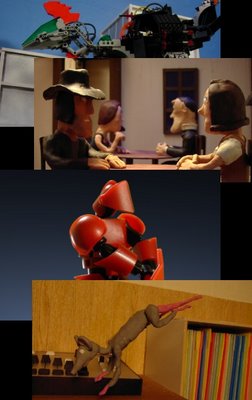Quirks of the iDshot
One of the seemingly great things about this camera when I first bought it was that it included a 730mb memory card, I don't think most cameras include cards this size, and 730mb is sure a nice start for free. However, it is a proprietary card (to the best of my knowledge it's like a miniDVD RW) and only is available in the 730mb size. Once you start shooting in full resolution tiffs thats only 10.5 seconds of 24fps animation, this becomes rather problematic. If you want to animate a shot over ten seconds long there are two options: first you can just shoot in jpg, its a compromise in quality but it will get you by, or you can transfer the pictures and wipe the card mid shot. Only do the later if your camera is connected to the computer at all times during the shot and is rock solid. To do this you need to turn the nob on the top to connect the camera to the computer, load the pictures to your PC. There is some kind of weird problem when you turn the nob back to picture taking mode, you will need to disconnect the camera from the fire wire card for the camera to acknowledge that it's back in shooting mode. Do this at the computer end, not where the fire wire goes into the camera, that way you won't bump the camera. For some reason, after you put the camera in transfer mode and back again the manual functions are turned off. To turn them back on you will need to push the button, and push on the opposite side of the camrea so that it counteracts the push and the camera is not bumped. That turns of the focus and white balance, but for some reason that exposure and shutter speed need to be turned on again, I have no idea why.

The next quirk is a weird issue with the aperture and zoom. I think there may have been a few topics about this on SMA.com. The more you zoom in the less you can open the aperture. For example if you are fully zoomed out the aperture can be set to 2.4, but if you are fully zoomed in the most it can be opened is 4.4. This is not so bad if you want to shoot at that aperture, however this directly affects the brightness of the viewfinder, so even though you can expose the hero frames longer you're frame grabbing image will be very dark. The way I handle this is to just not zoom in as much as possible. Zooming is not ideal because zoomed in images have less depth then zoomed out images. Besides, if you are shooting at full resolution you can use digital zoom anyway.
Perhaps the worst design flaw of the iDshot was the proprietary optical memory disk, rather then using some standard format they created what is basically a built in CD burner. The problem with this is that it is the only camera I have ever used that can overheat due to extensive use. I first encountered this problem when shooting Attack of the Evil Robotic Turkey [From Outer Space]. We where shooting a scene and had a light directly over the camera, this did not help the heating level of the camera one bit and we soon saw a temperature icon pop up on the screen, if this happens TURN THE CAMERA OFF. Don't do anything else, no picture transfers or anything. I recall some stories of people burning out the camera due to overheating, I have not had any problems because I turn it off if there is a problem. Keep in mind that every time you take a picture you create heat. If you are a very fast animator you will kill this camera. Pace yourself while shooting, for the good the the camera. Once you finish the shot and have the pictures on your computer turn the camera off and give a break, let it cool down.
As if overheating and burning out the camera weren't bad enough, the hotter the camera is, the more electronic noise (sometimes called rainbow dots by confused iDshot users). If you animated a shot that has rainbow dots in them you notice it starts out with none and they slowly fade in, this is seeing the effects of the rising heat of the camera. I've only just discovered this, or put one and one together. As far as I can tell there is less noise at faster shutter speeds, the noise becomes very noticeable at 1/4 sec and slower shutter speeds. If there are only a few dots here and there you can paint them out by had. I have used CompositeLab Pro (and VisionLab Studios when I upgraded) to create another layer of the video, mask out everything but the dot and a small space around it and apply a gaussian blur that lightens the dot. I'm sure After Effects users can do something equivalent fix. The noise has almost no effect on very light areas on the frame, if the dots get very bad you can gaussian blur the whole image and create another video layer that has anything that need to be in focus in it. The best solution to avoid this kind of work is to not shoot a 1/4 sec exposures or longer and keep the camera cool.

I know a few people have been asking about getting an iDshot, I beleave the only place that you can buy them new was selling them for around $400 last I checked and this camera is NOT worth $400, it is worth under $200, if you want one I would try and see if anyone on SMA.com wants to sell there iDshot, I'm sure there are quite a few that hardly used it and it's just sitting collecting dust.

